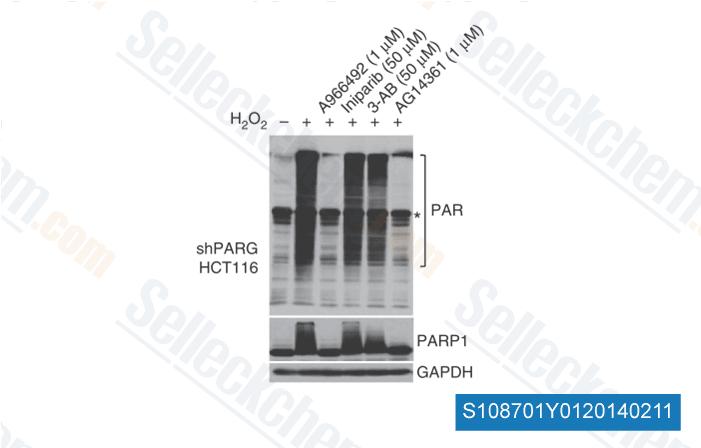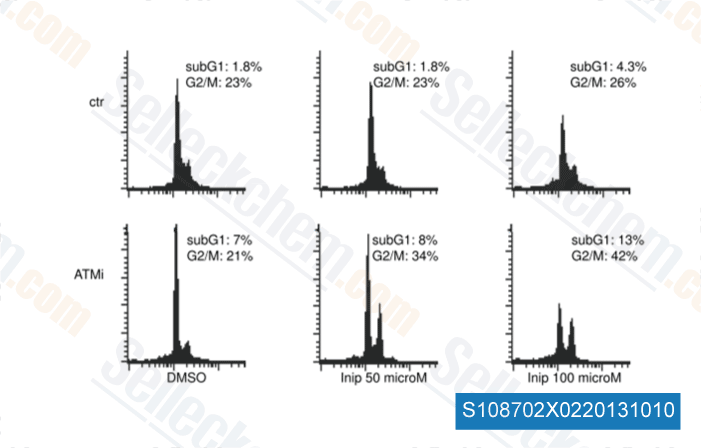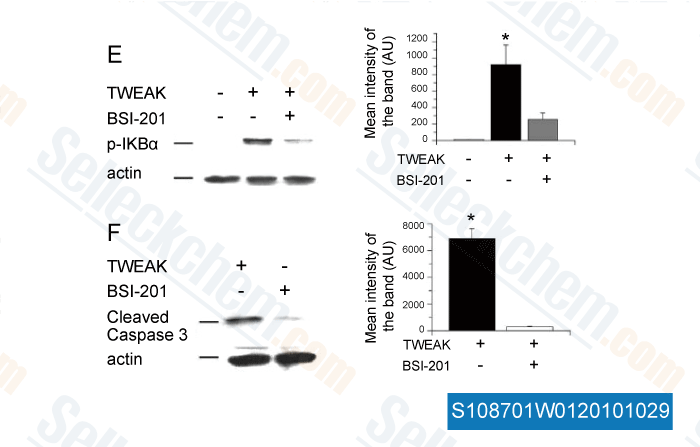|
Toll Free: (877) 796-6397 -- USA and Canada only -- |
Fax: +1-832-582-8590 Orders: +1-832-582-8158 |
Tech Support: +1-832-582-8158 Ext:3 Please provide your Order Number in the email. |
Technical Data
| Formula | C7H5IN2O3 |
|||
| Molecular Weight | 292.03 | CAS No. | 160003-66-7 | |
| Solubility (25°C)* | In vitro | DMSO | 58 mg/mL (198.6 mM) | |
| Ethanol | 28 mg/mL (95.88 mM) | |||
| Water | Insoluble | |||
|
* <1 mg/ml means slightly soluble or insoluble. * Please note that Selleck tests the solubility of all compounds in-house, and the actual solubility may differ slightly from published values. This is normal and is due to slight batch-to-batch variations. * Room temperature shipping (Stability testing shows this product can be shipped without any cooling measures.) |
||||
Preparing Stock Solutions
Biological Activity
| Description | Iniparib (BSI-201, NSC-746045, IND-71677) is a PARP1 inhibitor with demonstrated effectiveness in triple-negative breast cancer (TNBC). Phase 3. | |
|---|---|---|
| Targets |
|
|
| In vitro | BSI-201 is described as a prodrug of 4-iodo-3-nitrosobenzamide, an agent that covalently inhibits PARP1 by binding to its first zinc finger under cell-free conditions. Treatment of 120 μM BSI-201 plus buthionine sulfoximine (BSO) induces a 95% cell death among 855-2 cells, and displays a similar effect in other human cancer cells. [1] BSI-201 inhibits the growth of E-ras 20 cells, the effect of which can be augmented 4-fold when BOS is added. [2] Recently BSI-201 shows no ability to inhibit PARP enzymatic or cellular activity, but can non-selectively modify cysteine-containing proteins in tumor cells, suggesting the mechanism of action for BSI-201 is likely not via inhibition of PARP activity. [3] BSI-201 (100 μM) inhibits ionizing radiation-induced single-strand breaks (SSBs) repair in human lymphoid cell lines based on large endogenous Epstein–Barr virus (EBV) circular episomes assay, resulting in 55% repair by 2 hours, which can be reversed surprisingly by knockdown of PARP1, indicating that the mechanism of inhibition does not involve trapping PARP at SSBs. [4] BSI-201 is not able to selectively kill homologous recombination (HR)-deficient cells between BRCA2-deficient PEO1 and BRCA2-revertant PEO4, or ATM-deficient GM16666 and ATM-restored GM16667 fibroblasts. BSI-201 is cytotoxic to a variety of cell lines at concentrations above 40 μM reflecting a mechanism independent of PARP. [5] |
Protocol (from reference)
| Cell Assay:[3] |
|
|---|
References
Customer Product Validation

-
Data from [Data independently produced by Nat Methods , 2013, 10(10), 981-4]

-
Data from [J Exp Clin Cancer Res, 2013, 32(1), 95 ]

-
Data from [Neuroscience, 2010, 171, 1256–1264]
Selleck's Iniparib (BSI-201) has been cited by 16 publications
| Coupling cellular drug-target engagement to downstream pharmacology with CeTEAM [ Nat Commun, 2024, 15(1):10347] | PubMed: 39643609 |
| Histone Parylation factor 1 contributes to the inhibition of PARP1 by cancer drugs [ Nat Commun, 2021, 12(1):736] | PubMed: 33531508 |
| Synergistic Anti-Tumor Effect of Combining Selective CDK7 and BRD4 Inhibition in Neuroblastoma [ Front Oncol, 2021, 11:773186] | PubMed: 35198433 |
| PARP1-cGAS-NF-κB pathway of proinflammatory macrophage activation by extracellular vesicles released during Trypanosoma cruzi infection and Chagas disease. [ PLoS Pathog, 2020, 21;16(4):e1008474] | PubMed: 32315358 |
| The PARP inhibitor AZD2281 (Olaparib) induces autophagy/mitophagy in BRCA1 and BRCA2 mutant breast cancer cells. [ Int J Oncol, 2015, 47(1):262-8] | PubMed: 25975349 |
| Synergistic Effect of Trabectedin and Olaparib Combination Regimen in Breast Cancer Cell Lines. [ J Breast Cancer, 2015, 18(4):329-38] | PubMed: 26770239 |
| Pharmacological Inhibition of Poly(ADP-Ribose) Polymerases Improves Fitness and Mitochondrial Function in Skeletal Muscle. [Pirinen E, et al. Cell Metab, 2014, 19(6):1034-41] | PubMed: 24814482 |
| Effect of a poly(ADP-ribose) polymerase-1 inhibitor against esophageal squamous cell carcinoma cell lines [Nasuno T Cancer Sci, 2014, 105(2):202-10] | PubMed: 24219164 |
| Cardamonin inhibits angiotensin II-induced vascular smooth muscle cell proliferation and migration by downregulating p38 MAPK, Akt, and ERK phosphorylation. [Shen YJ J Nat Med, 2014, 68(3):623-9] | PubMed: 24595849 |
| A proposed screening paradigm for discovery of covalent inhibitor drugs. [ Drug Metab Lett, 2014, 8(1):19-30] | PubMed: 24628405 |
RETURN POLICY
Selleck Chemical’s Unconditional Return Policy ensures a smooth online shopping experience for our customers. If you are in any way unsatisfied with your purchase, you may return any item(s) within 7 days of receiving it. In the event of product quality issues, either protocol related or product related problems, you may return any item(s) within 365 days from the original purchase date. Please follow the instructions below when returning products.
SHIPPING AND STORAGE
Selleck products are transported at room temperature. If you receive the product at room temperature, please rest assured, the Selleck Quality Inspection Department has conducted experiments to verify that the normal temperature placement of one month will not affect the biological activity of powder products. After collecting, please store the product according to the requirements described in the datasheet. Most Selleck products are stable under the recommended conditions.
NOT FOR HUMAN, VETERINARY DIAGNOSTIC OR THERAPEUTIC USE.
